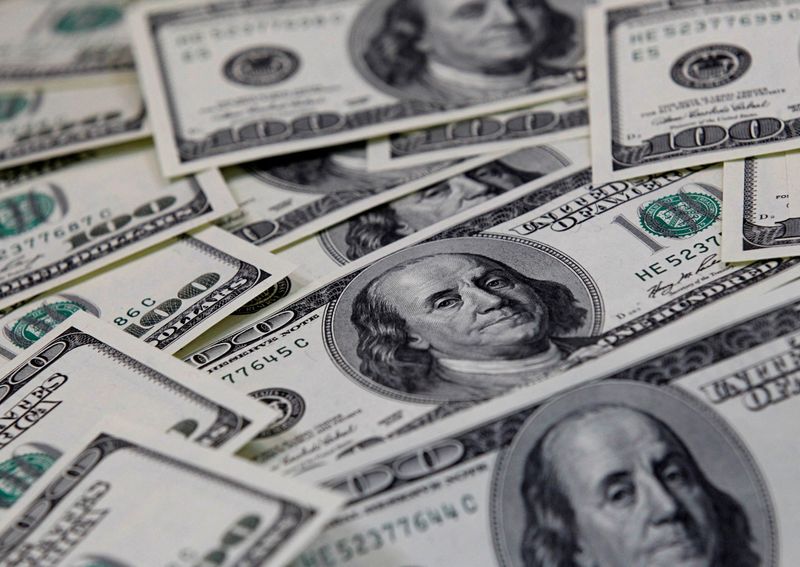
© Reuters. FILE PHOTO: U.S. one hundred dollar notes are seen in this picture illustration taken in Seoul February 7, 2011. REUTERS/Lee Jae-Won
By Karen Brettell
NEW YORK (Reuters) – The hit a four-week high on Thursday after data pointed to a strong jobs market, supporting the prospect that the Federal Reserve could keep up the pace of aggressive rate hikes.
Private employment increased by 235,000 jobs last month, the ADP National Employment report showed on Thursday, a day before Friday’s highly anticipated December employment report. Economists polled by Reuters had forecast private jobs increasing 150,000.
Separately, the number of Americans filing new claims for unemployment benefits dropped to a three-month low last week, while layoffs fell 43% in December.
“Good news (on the data) ‘is’ bad news for stocks, but terrific news for the buck,” said Joe Manimbo, senior market analyst, at Convera in Washington. “The economy showing surprising momentum at the turn of the year keeps soft landing hopes intact and underscores the Fed’s higher for longer rate outlook.”
The dollar gained 0.84% against a basket of currencies to 105.07, after earlier reaching 105.27, the highest since Dec. 8.
Friday’s government jobs and wage data for December is this week’s major economic focus as investors gauge how high the U.S. central bank is likely to raise rates, and for how long.
“The payrolls and the wage data is very key for the Fed’s stance,” said Lou Brien, a market strategist at DRW Trading in Chicago, though he noted that Fed moves were not contingent on one piece of data, with each release representing more “tiles in the mosaic.”
It is expected to show that employers added 200,000 jobs in the month, while average hourly earnings are predicted to have risen 0.4% in December for an annual increase of 5%.
Consumer price data for December, due on Jan. 12, is expected to show that headline prices gained by 0.1% in December while core prices increased 0.3%.
Fed funds futures traders increased their bets on Thursday that the Fed could hike rates by 50 basis points at its meeting concluding on February 1. It is now seen as a 42% chance, up from 31% on Wednesday morning, with a 25 basis points increase still seen as more likely.
Brien said that it would likely take “something extraordinary” in terms of much higher than expected inflation or wage gains for the Fed to raise rates by 50 basis points next month, with Fed officials now preferring to move in more gradual 25 basis point increments as they evaluate the impact of higher rates.
The Fed slowed the pace of its rate hikes to 50 basis points in December, following four consecutive 75-basis point increases.
Minutes from the Fed’s December meeting released on Wednesday emphasized “the need to retain flexibility and optionality when moving policy to a more restrictive stance,” but also expressed concern about any “misperception” in financial markets that their commitment to fighting inflation was flagging.
Atlanta Fed President Raphael Bostic said on Thursday that inflation was the biggest headwind facing the U.S. economy right now and U.S. Federal Reserve officials “remain determined” to lower it back to the central bank’s 2% target.
Kansas City Fed leader Esther George also warned that the Fed will likely need to press forward with rate rises and keep them high for some time once the tightening process ends.
The greenback pared some of its gains, however, after St. Louis Fed President James Bullard said that the new year could finally bring some welcome relief on the inflation front.
The euro was last down 0.74% against the euro at $1.0526, after the single currency earlier dipped as low as $1.0515, the lowest since Dec. 12. The greenback also gained 0.51% against the Japanese yen to 133.27.
The yen has rebounded dramatically from a more than 30-year low of 151.94 reached in October. After a tweak last month, traders are betting the Bank of Japan (BOJ) will soon fully abandon its yield curve control (YCC) policy.
The BOJ is putting more emphasis on an inflation gauge that excludes fuel costs and will likely raise its projections for the index’s growth in quarterly forecasts due this month, sources told Reuters.
“We’re on our way out of YCC, so it’s just a question of timing,” said James Malcolm, head of FX strategy at UBS.
Sterling dropped 1.17% to $1.1916, after earlier reaching $1.18730, the lowest since Nov. 23.
========================================================
Currency bid prices at 3:16PM (2016 GMT)
Description RIC Last U.S. Close Pct Change YTD Pct High Bid Low Bid
Previous Change
Session
Dollar index 105.0700 104.2100 +0.84% 1.527% +105.2700 +103.9800
Euro/Dollar $1.0526 $1.0605 -0.74% -1.76% +$1.0631 +$1.0515
Dollar/Yen 133.2700 132.6250 +0.51% +1.67% +134.0450 +131.6900
Euro/Yen 140.30 140.62 -0.23% +0.00% +141.3500 +139.9900
Dollar/Swiss 0.9363 0.9298 +0.70% +1.26% +0.9377 +0.9263
Sterling/Dollar $1.1916 $1.2059 -1.17% -1.46% +$1.2077 +$1.1873
Dollar/Canadian 1.3575 1.3480 +0.71% +0.20% +1.3595 +1.3471
Aussie/Dollar $0.6755 $0.6839 -1.22% -0.90% +$0.6845 +$0.6737
Euro/Swiss 0.9853 0.9857 -0.04% -0.42% +0.9872 +0.9834
Euro/Sterling 0.8831 0.8794 +0.42% -0.15% +0.8862 +0.8792
NZ $0.6232 $0.6291 -0.83% -1.75% +$0.6309 +$0.6212
Dollar/Dollar
Dollar/Norway 10.2690 10.0950 +1.48% +4.39% +10.2800 +10.0415
Euro/Norway 10.8039 10.6780 +1.18% +2.96% +10.8281 +10.6716
Dollar/Sweden 10.6873 10.5019 +1.03% +2.69% +10.6999 +10.4853
Euro/Sweden 11.2504 11.1360 +1.03% +0.90% +11.2705 +11.1357
